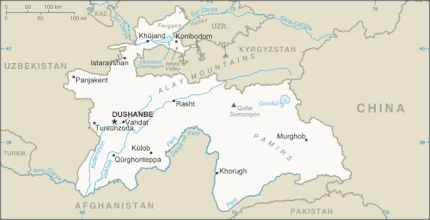Portal:Tajikistan
The Tajikistan Portal
Tajikistan (/tɑːˈdʒiːkɪstɑːn/ ( The territory that now constitutes Tajikistan was previously home to several ancient cultures, including the city of Sarazm of the Neolithic and the Bronze Age and was later home to kingdoms ruled by people of different faiths and cultures, including the Oxus civilization, Andronovo culture, Buddhism, Nestorian Christianity, Hinduism, Zoroastrianism, Manichaeism, and Islam. The area has been ruled by numerous empires and dynasties, including the Achaemenid Empire, Sasanian Empire, Hephthalite Empire, Samanid Empire, and Mongol Empire. After being ruled by the Timurid Empire and Khanate of Bukhara, the Timurid Renaissance flourished. The region was later conquered by the Russian Empire and subsequently by the Soviet Union. Within the Soviet Union, the country's modern borders were drawn when it was part of Uzbekistan as an autonomous republic before becoming a full-fledged Soviet republic in 1929. (Full article...) Selected article - A Belarusian tractor in Tajikistan Tajikistan is a highly agrarian country, with its rural population at more than 70% and agriculture accounting for 60% of employment and around 20% of GDP in 2020. As is typical of economies dependent on agriculture, Tajikistan has a low income per capita: Soviet Tajikistan was the poorest republic with a staggering 45% of its population in the lowest income “septile” (Uzbekistan, the next poorest in the Soviet ranking, had 34% of the population in the lowest income group). In 2006 Tajikistan still had the lowest income per capita among the Commonwealth of Independent States (CIS) countries: $1,410 (purchasing power parity (PPP) equivalents) compared with nearly $12,000 for Russia. The low income and the high agrarian profile justify and drive the efforts for agricultural reform since 1991 in the hope of improving the population's well-being. Tajikistan's agriculture is characterized by two farming systems determined by its geography, where potato and wheat farming, along with horticulture is taking place in the country's uplands, while irrigated cotton dominates in lowlands. (Full article...)Did you know? -Subcategories Tajikistan Tajikistan-related lists Buildings and structures in Tajikistan Tajikistani culture Economy of Tajikistan Education in Tajikistan Environment of Tajikistan Geography of Tajikistan Government of Tajikistan Health in Tajikistan History of Tajikistan Organizations based in Tajikistan Tajikistani people Politics of Tajikistan Society of Tajikistan Images of Tajikistan Tajikistan stubs General imagesThe following are images from various Tajikistan-related articles on Wikipedia.
Related portalsTopicsThings you can do
Selected image Credit: User:VargaA Qurghonteppa, Tajikistan
WikiProjects
Associated WikimediaThe following Wikimedia Foundation sister projects provide more on this subject:
Discover Wikipedia using portals
| ||||||||














%252C_Temple_of_the_Oxus%252C_Takht-i-Sangin%252C_3rd-2nd_century_BCE_(left_side).jpg.webp)


.JPG.webp)




.jpg.webp)


%252C_visiting_the_court_of_the_Tang_Dynasty._The_Gathering_of_Kings_(%E7%8E%8B%E4%BC%9A%E5%9B%BE)_circa_650_CE.jpg.webp)
